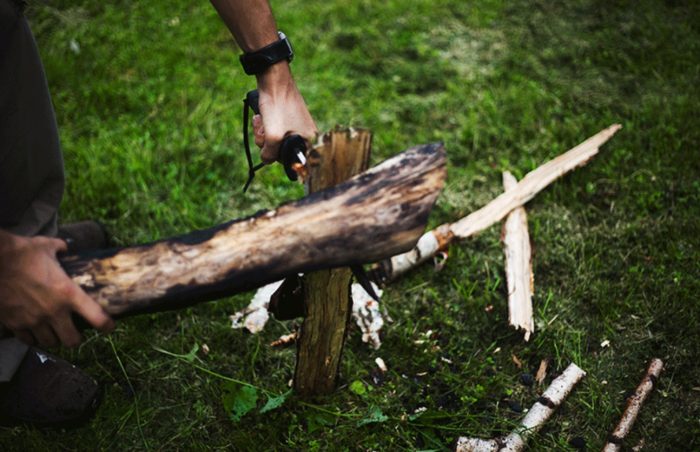There are pros and cons to everything and this is no different. I am positive that at some point in your life between camping, survival, prepping and homesteading you will come across the need to split wood and this is one technique that always works well, that is if you do it correctly.
Advantages:
In many instances, batoning makes the process of splitting wood far easier than it’s alternative, chopping wood.
- less effort
- takes less time
- less experience to master than chopping
- and results in a much cleaner cut than chopping
Disadvantages:
- In the case of batoning wet logs, batoning can be somewhat difficult.
- Batoning can also sometimes damage or even break the tool being struck.
To reduce difficulties and knife breakage, proper batoning technique should be used (see the section below on proper batoning technique).
A piece of wood is the best tool to use for a baton. Rocks, bricks, and other extremely hard objects will work, but they will severely damage the spine of the knife you are using to baton. The best piece of wood to use is a piece of hardwood. If you would like to make a more comfortable batoning tool, say if you’re going to be batoning a lot of wood, shape your piece of wood to look something like a short baseball bat: debark it, and thin out a handle, then shave it down until it is smooth to the grip. The goal is to make a batoning tool with a wider hitting surface, and a thinner handle surface.
Proper Technique:
- Center the knife in the middle of the piece of wood you are trying to split.
- Place the knife straight down, and not at an angle, when getting ready to baton (this is very important to mitigate damage or breakage to the knife). Hit the center of the knife with the baton until the knife is properly lodged in the wood, then proceed to the next step.
- Baton on the blade end of the knife, but do not hit the very tip of the blade when batoning, as the tip of the knife is usually relatively weak and susceptible to breakage. The metal of the knife should protrude from the wood far enough so that you can hit, not the tip, but a part of the spine that is strong enough to take the batoning.
- Readjust the knife, correcting the blade orientation by making the knife straight again, if it happens to shift to an angle after having been batoned for some time. Make gentle, corrective taps to the handle end of the knife when batoning whenever the blade begins to stray from it’s original downward alignment. Do not hit the handle as hard as you would hit the blade end of the knife, as the force may cause the knife to break or be damaged, but feel free to make light hits to the handle end when you feel it is appropriate.
Sometimes when you are just getting started things do not always go according to plan. So here are some tips and tricks to help you figure out why things just aren't quite right.
- Baton with the grain of the wood, not against it.
- If possible, baton around and not through knots in the wood, as knots create sometimes extreme resistance and can, in certain situations, damage the edge of the knife.
- If the log already has a crack, take advantage of it, as mother nature has already done most of the work for you. Align the knife on top of the crack and go through as you would normally.
- Move the piece of wood you are trying to baton to rest on the hardest surface you can find. Ideal surfaces include large rocks, a second log, or, in more urban settings, concrete.
- Use a more appropriate knife (see the Ideal Batoning Knife section above).
- If you simply cannot baton through a particular piece of wood, try batoning a smaller one (in terms of it’s diameter or radus), as batoning becomes easier with thinner pieces of wood.
- Hardwood is of course much more difficult to baton through than softwood (like balsa). Adjust expectations accordingly in terms of expansion of energy, and if it doesn’t matter whether you have hardwood or softwood, switch to batoning a softwood instead.
So what do you think? Have you used this method before? If so what are some tips that you can share with us? Leave them in the comments below.
Source: More Than Surviving.

The correct batoning method is use an axe
There is literally no reason to baton